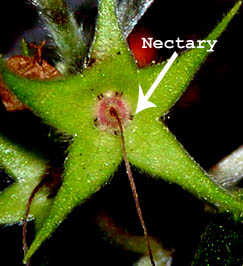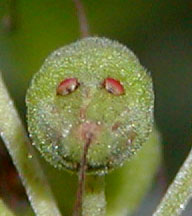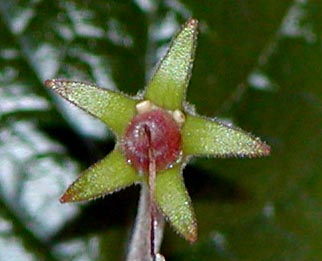| Species list |
Hybrids list |
Tubers list |
Topics list |
Site index |
What's new |
Home page |
Don't know much about nectary, Don't know much taxonomy...
Sinningia flowers reward their pollinators with nectar (see the etymology), produced in floral structures called nectaries. If I had a digital microscope, I could take some cool closeups so I could figure out how they work, but mostly I see the nectaries after the flowers fall off, by which point they (the nectaries) are dried up.
On the flower comparison page, you can see that sinningia flowers normally have an inflated base for holding the nectar. This means that the nectaries are also located at the base of the flower.

This picture shows the calyx of Sinningia gerdtiana after the corolla has fallen off. In the center of the picture is the ovary, to which the withered style is still attached.
In a ring around the ovary are five nectaries, each looking something like a quotation mark. Note that the nectaries alternate with the calyx lobes (sepals); that is, they coincide with the junctions of two lobes, rather than being situated at the base of a single lobe. Since the corolla lobes also alternate with the calyx lobes, each nectary is therefore aligned with the base of a corolla lobe.
Five is the base number for nectaries in the gesneriad family and in the sinningia alliance. I believe that the original arrangement in the alliance is five separate nectaries, as in this case.
Sinningia speciosa hybrid flowers often have more than five petals. A picture on the Sinningia speciosa page shows a flower with six nectaries.

This is not an alien, it is Sinningia macrostachya. Here we see a different arrangement of nectaries. Instead of a ring or five separate nectaries, there are two separate nectaries, at the base of the upper two corolla lobes (or, in this picture, where the corolla lobes were). I believe this arrangement is characteristic of the Dircaea clade, which includes many familiar species such as S. cardinalis and S. leucotricha. In many of these species, however, the calyx lobes wrap tightly over the fruit after the corolla drops, making it difficult to photograph the nectaries. S. macrostachya is nice enough to be an exception.

This picture shows the paired nectaries of Sinningia 'Texas Zebra', a hybrid by Dale Martens. Its ancestors include Sinningia striata and Sinningia eumorpha, but probably all its ancestors are members of the Dircaea clade mentioned above. Like S. macrostachya, it has paired nectaries. This picture clearly shows that the two white nectaries alternate with the calyx lobes. Thus they will correspond to the two upper lobes of the corolla.
This fruit is the result of applying pollen from S. 'Peninsula Belle'. Seeds were harvested and sown, and some of the progeny have flowered. See the Texas Zebra page for pictures.
There is a closeup of paired nectaries, on the Sinningia barbata page.
There is a picture of a single bilobed nectary on the Sinningia cardinalis page.